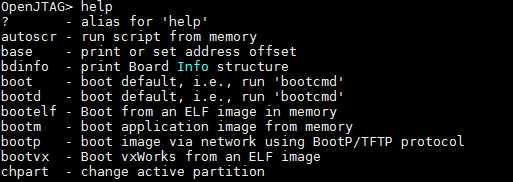标签:实现机制 img big 串口 命令行 操作 匹配 typedef dtp
学习目标:
1、了解u-boot-1.1.6中命令的实现机制
2、掌握如何在u-boot-1.1.6中添加自定义命令
1、命令的实现机制
uboot运行在命令行解析模式时,在串口终端输入uboot命令,按下回车后,系统将执行命令的相应操作。以help命令为例,当输入help命令,并按下回车时,串口终端打印当前uboot支持的所有命令的帮助信息,如下图所示(图片仅截取部分):

到这里我们应该很好奇uboot的命令是如何实现的呢?想要知道命令如何实现,最简单的办法就是在uboot工程中搜索“help”关键词。通过查找在common/command.c源码文件中找到了uboot命令的定义:
U_BOOT_CMD( help, CFG_MAXARGS, 1, do_help, "help - print online help\n", "[command ...]\n" " - show help information (for ‘command‘)\n" "‘help‘ prints online help for the monitor commands.\n\n" "Without arguments, it prints a short usage message for all commands.\n\n" "To get detailed help information for specific commands you can type\n" "‘help‘ with one or more command names as arguments.\n" );
这里我们并不知道U_BOOT_CMD是什么,还需再进行查找。通过进一步查找,可以发现U_BOOT_CMD是一个宏,这个宏在include/command.h头文件中定义,U_BOOT_CMD宏的原型如下:
#define Struct_Section __attribute__ ((unused,section (".u_boot_cmd")))
#ifdef CFG_LONGHELP #define U_BOOT_CMD(name,maxargs,rep,cmd,usage,help) \ cmd_tbl_t __u_boot_cmd_##name Struct_Section = {#name, maxargs, rep, cmd, usage, help} #else /* no long help info */ #define U_BOOT_CMD(name,maxargs,rep,cmd,usage,help) \ cmd_tbl_t __u_boot_cmd_##name Struct_Section = {#name, maxargs, rep, cmd, usage} #endif /* CFG_LONGHELP */
这里采用条件编译的方式,如果宏CFG_LONGHELP被定义,#ifdef 到#else之间的语句被编译,否者#else到#endif之间的语句被编译。这里我们假设宏CFG_LONGHELP(表示是否支持长的帮助信息)在其他处被定义,按照#ifdef和#else之间的宏定义格式将上述的help命令实现U_BOOT_CMD(help,....)展开,展开后的形式如下:
cmd_tbl_t __u_boot_cmd_help __attribute__ ((unused,section (".u_boot_cmd"))) = {help, CFG_MAXARGS, 1, do_help, "help - print online help\n", "[command ...]\n" " - show help information (for ‘command‘)\n" "‘help‘ prints online help for the monitor commands.\n\n" "Without arguments, it prints a short usage message for all commands.\n\n" "To get detailed help information for specific commands you can type\n" "‘help‘ with one or more command names as arguments.\n" }
将help命令实现U_BOOT_CMD(help,....)展开,可以看出其实U_BOOT_CMD(help,....)就是定义了一个cmd_tbl_t类型的结构体变量,变量名为__u_boot_cmd_help,比较特别的是这个变量被强加了__attribute__属性,编译器在进行链接时,将该变量放在了名为".u_boot_cmd"自定义段的地址中。下面来看cmd_tbl_t结构体的声明形式:
struct cmd_tbl_s { char *name; /* Command Name */ int maxargs; /* maximum number of arguments */ int repeatable; /* autorepeat allowed? */ /* Implementation function */ int (*cmd)(struct cmd_tbl_s *, int, int, char *[]); char *usage; /* Usage message (short) */ #ifdef CFG_LONGHELP char *help; /* Help message (long) */ #endif #ifdef CONFIG_AUTO_COMPLETE /* do auto completion on the arguments */ int (*complete)(int argc, char *argv[], char last_char, int maxv, char *cmdv[]); #endif }; typedef struct cmd_tbl_s cmd_tbl_t;
name:命令的名称(很重要)
maxargs :命令所支持的最大参数
repeatable :命令是否可重复
cmd:回调函数,执行命令便是调用该回调函数
usage:对应短的帮助信息
help :对应长的帮助信息
那么这些定义的命令是如何被调用呢?通过再次查找我们找到了最底层的命令查找函数find_cmd,其源码如下:
cmd_tbl_t *find_cmd (const char *cmd) { cmd_tbl_t *cmdtp; cmd_tbl_t *cmdtp_temp = &__u_boot_cmd_start; /*Init value */ const char *p; int len; int n_found = 0; /* * Some commands allow length modifiers (like "cp.b"); * compare command name only until first dot. */ len = ((p = strchr(cmd, ‘.‘)) == NULL) ? strlen (cmd) : (p - cmd); for (cmdtp = &__u_boot_cmd_start; cmdtp != &__u_boot_cmd_end; cmdtp++) { if (strncmp (cmd, cmdtp->name, len) == 0) { if (len == strlen (cmdtp->name)) return cmdtp; /* full match */ cmdtp_temp = cmdtp; /* abbreviated command ? */ n_found++; } } if (n_found == 1) { /* exactly one match */ return cmdtp_temp; } return NULL; /* not found or ambiguous command */ }
通过find_cmd命令我们可以大概猜测出uboot命令实现机制:
2、添加自定义命令
通过上面的一步步分析,我们知道了uboot命令的实现机制,现在就动手添加一个简单的自定义命令custom。自定义命令实现功能:执行该命令打印“This is a custom command”语句。
①在uboot根目录下common文件夹中新建一个名为cmd_custom.c的文件,添加文件内容如下:
#include <common.h> #include <command.h> /* *No utility functions, only for testing */ int do_custom (cmd_tbl_t * cmdtp, int flag, int argc, char *argv[]) { printf("This is a custom command\n"); printf("argc = %d\n", argc); } U_BOOT_CMD( custom, CFG_MAXARGS, 1, do_custom, "User-defined functions\n", "User-defined functions, the function is implemented in the cmd_custon.c file\n" );
②将代码上传服务器,修改uboot根目录下的Makefile文件,将cmd_custom.o添加到Makefile中COBJS变量里
③执行make命令,重新编译uboot
④烧写新的uboot到flash中
⑤进入uboot命令行解析模式,执行custom命令,结果如下图所示:

⑥执行help custom命令打印custom命令行长的帮助信息

根据执行结果来看,添加自定义命令成功!
标签:实现机制 img big 串口 命令行 操作 匹配 typedef dtp
原文地址:https://www.cnblogs.com/053179hu/p/10625278.html